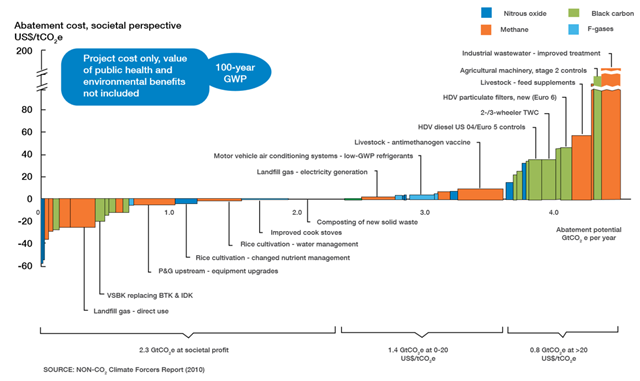Cutting short-lived climate pollutants: A win-win for development and climate
3 September 2013 (World Bank) – Some of the easiest targets for lowering greenhouse gas emissions are right in front of us every day: black carbon from diesel-fueled vehicles and solid fuel cooking fires, methane from solid waste, hydrofluorocarbons from aerosols. These are short-lived climate pollutants, named for their relatively short lifespan in the atmosphere. Reducing them now can buy time as countries work to lower their longer-lasting carbon emissions, and their reduction can provide immediate co-benefits for health and agriculture at the same time. A new report, Integration of Short-Lived Climate Pollutants in World Bank Activities, identifies ways that the World Bank can do more through its projects to reduce the emission of the short-lived climate pollutants (SLCPs): black carbon, methane, tropospheric ozone, and fluorinated gases known as HFCs. The review highlights ways the Bank’s investments are already reducing SLCPs and shows where potential exists for even greater reduction. It discusses a wide range of SLCP-reducing activities, including:
- bus and rail-based transport systems, which can reduce black carbon emissions and have strong, local public health co-benefits;
- solid waste collection and disposal methods that can reduce methane emissions;
- improved cookstoves and kilns that can reduce black carbon; and
- rice irrigation and wastewater management that can lower methane emissions and have global benefits to agricultural productivity and health.
From financial years 2007 to 2012, 7.7 percent of World Bank commitments – approximately US$ 18 billion – went into “SLCP-relevant” activities in energy, transport, roads, agriculture, forestry, and urban waste and wastewater. The report suggests that more can be done. The report, prepared at the request of the G8, was released today by World Bank Vice President for Sustainable Development Rachel Kyte at the High-Level Assembly of the Climate and Clean Air Coalition “While we continue – and must continue – to hammer away at reducing CO2 emissions, efforts to reduce these short-lived climate pollutants can have an immediate effect on slowing warming and the resulting consequences of more extreme weather and devastating sea-level rise,” Kyte said. “From our perspective, aggressive action to reduce SLCPs is critically important as it provides our clients, developing countries, especially the poorest and most vulnerable, a critical opportunity to adapt to our changing climate,” she said. “At the same time, reducing these pollutants can reap huge health, agriculture and other development benefits.” According to the United Nations Environment Programme (pdf), fast action to reduce SLCPs could avoid an estimated 2.4 million premature deaths from outdoor air pollution annually by 2030 and avoid about 32 million tons of crop loss per year. It could also have a direct impact on climate change, with the potential to reduce the warming expected by 2050 by up to 0.5 degrees Celsius. To better integrate SLCP-reducing activities into the World Bank’s day-to-day operations, the report proposes developing more comprehensive economic analysis that can account for all local and global benefits that projects could provide due to SLCP emission reductions. “World Bank lending operations actively contribute to the sustainable development priorities of countries,” said Sameer Akbar, the lead author of the report and a senior environmental specialist at the World Bank. “Many of the activities associated with these operations also reduce SLCPs. Reduction of SLCPs can improve air quality and public health, and strengthen food security.” “Going forward, the goal is to transform as many of the World Bank activities – with the potential to reduce emissions – into SLCP reducing activities,” said Akbar.
Projects already reducing SLCPs
The World Bank is already working on addressing some of these pollutants. The Mexico Sustainable Rural Development Project serves as a powerful example of how SLCP reductions are already being delivered. Through a $100 million World Bank loan, blended with a $10.5 million GEF grant, the Government of Mexico has been able to co-fund the installation of more than 300 bio-digesters on smallholder pig and dairy farms, reducing manure-related methane emissions and reliance on fossil-fuel electricity while providing jobs and other economic co-benefits. In South Asia, the Bank has projects aimed at improving indoor and outdoor air quality focusing on reducing emissions from the brick making and transportation sectors. With funding from the Montreal Protocol, China will reduce its production of hydrochlorofluorocarbons (HCFCs) by 10% between now and 2015. Overall, since 2011, five projects that phase-out HCFCs (pdf) are estimated to avoid nearly 27 million tons of CO2 equivalent annually through alternative technology choices. A bus rapid transport project in Cebu, Philippines (pdf), is estimated to save anywhere between US$94 and US$135 million in direct health costs. Additionally, 52 World Bank carbon finance projects, with an investment of US$543 million (pdf), is estimated to avoid 150 premature deaths due to improved air quality and prevent 375,000 tons of methane emissions each year. Earlier this year, a report by the Methane Finance Study Group (convened by the World Bank, also at the request of the G8) found that a relatively small investment could bring fast and significant reductions in the powerful greenhouse gas methane. According to the report, reductions of as much as 8,200 million tons of CO2 equivalent could be delivered in developing countries at less than $10 per ton in incremental cost financing—a gap which can be closed by pay-for-performance mechanisms. Methane is over 25 times more potent than CO2 at warming the planet.
Cutting Short-Lived Climate Pollutants: A Win-Win for Development and Climate
